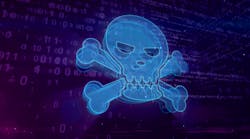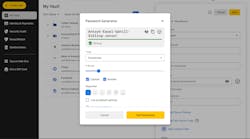Combating cybersecurity threats is a constant concern for college students the minute they open an internet browser. Online students are especially vulnerable to these threats because of the increased amount of time they spend on their computers doing schoolwork and taking exams. More time online means more opportunities for cybercriminals to infiltrate a network.
At Maryville University, we strive to be extremely proactive and provide cybersecurity awareness for our students the minute they enroll in one of our undergraduate or graduate degree programs. The sooner they know about these looming threats, the sooner they can become part of the line of defense to stop them.
Once they complete their initial admissions tour, new students — both online and on campus — complete a security awareness briefing to bring them up to speed on some of the threats they’re likely to encounter while attending college and how to take steps to curtail those threats. This also helps raise their cybersecurity awareness when approaching both online and physical activity outside of their schoolwork.
We periodically send resources and information to students regarding events that are going on around the country and the world that pertain to cybersecurity threats and incidents.
For example, around election time, some students might receive more campaign emails than usual and, as a result, be more likely to let their guard down and open a phishing email.
We let them know different ways that they can be proactive in monitoring those emails and forwarding them to our information technology security department so that they won’t become victims of cybercrime by clicking on a malicious link for example. It’s an effective way to keep cybersecurity top of mind at a peak time for malicious online attacks.
The Phishing attack vector is still the No. 1 way that cyber criminals introduce viruses or malware that can cause great harm to computer networks, but these hackers continue to look for ways to infiltrate servers and steal Personal Identifiable Information (PII) from unsuspecting users.
Constant Change
While the global pandemic brought about a significant increase in online learning, it also forced more than half the workforce to transition to work from home (WFH). That dynamic also increases the need for stronger cybersecurity, with the uptick in remote access to servers and the amount of home network usage.
The equipment that our students get from their Internet Service Provider (ISP), whether a Wi-Fi router or a device hub, comes with default settings. I often ask them in class, “How many of you have changed that password or reconfigured that router?” Typically, it’s not a lot; it’s not something that most people commonly do in those situations.
One small thing like changing that password to a longer, more complex password or passphrase makes it a little more difficult for cybercriminals to infiltrate a system. We want to make sure that when students connect to Maryville Online through their home network, they’re even more secure because they have taken these simple precautions.
Maryville University has a password policy of changing passwords every 90 days, so we change them even more frequently to keep the network safe. The more students change their passwords and default settings, the greater the chance they have of avoiding cybercrime and preventing an attempted hack.Testing Limits
Taking exams is one of the bigger concerns for universities when it comes to online learning. Recently, a student at Cleveland State University argued that scanning his bedroom before he took an online exam was unconstitutional, and a judge agreed with the student.
The key factor to this element of online learning is making sure that any of the vendors that we use have the appropriate security and privacy clauses to solidify the integrity of the exam and the online safety of the students.
Whether we’re proctoring an asynchronous exam or a professor is on the other side of virtual testing, monitoring the area of the background and making sure that nothing inappropriate is happening is our priority.
No matter which type of exam students take online or the type of environment they take it in, we give a clause saying you’re bound to ensure that “you and only you are conducting this exam.”
On the back end, we ensure that the software and services that we use for testing don’t allow students to open additional windows or other web browsers that could aid them while they’re taking an exam. With asynchronous exams, we also make sure that the camera is on and that no one is around the student who’s taking the test.
Another major development that’s increased the need for cybersecurity in recent years is the advent of the cloud network and cloud storage. It’s also another element of being an online student that can be cause for concern in protecting personal information. Some organizations and industries that had big data centers and on-ground servers are now seeing the migration of some of that data to the cloud. How do we protect that information? Cloud security companies that protect sensitive data from breaches are in high demand.
Higher education has adopted the cloud, so staying ahead of the curve with cybersecurity to protect information is of the utmost importance for our university. To that end, knowledge of cloud safety is also key for our students to learn as they complete the bachelor’s or master’s degree in cybersecurity programs.
We have a Cloud Migration and Security course in the Master of Science in Cybersecurity program. We know that students who have any cloud experience on their resumes are more marketable — yet another advantage to staying on top of the ever-evolving cybersecurity threats that face the world.
Planning for the Inevitable
In 2022, the number of data breaches has increased by more than 100 million since 2005. When it comes to getting breached, companies are understanding that it’s not if, it’s when. They must be able to respond to ransomware incidents quickly to shut down the threat to their internal property as well as that of their clients.
Those companies need to make sure that they have a workforce with the skill level to assess what’s going on and know whom to contact. Even with the constant online security threats, the number of organizations that don’t have incident response plans is staggering.
The need to have the necessary skill set to shut down cybercrime threats is sure to continue to rise. That’s why two of our courses — Cloud Migration and Security, and Virtualization and Cloud Security — are especially beneficial to our students as future leaders in the field.
Our students must be aware of new cybersecurity threats the minute they’re exposed to the world, so staying informed is one of the most important parts of working in the field.
With the increase in online threats, the interest in cybersecurity has grown significantly. We see this with the rising enrollment in our program each year at Maryville University. It’s a growing career field that isn’t likely to go away anytime soon.
Our program also has a 98% career outcome rate in terms of getting students into full-time jobs, the military, or continuing their education with a graduate degree. The career outcomes of graduates of our program are diverse, ranging from Fortune 100 companies to federal government agencies and private companies.
Students are recognizing the importance of keeping online information safe from cyber criminals and choosing to be part of the solution on a national scale. In fact, we have students interning with the Federal Bureau of Investigation (FBI) right now.
We’ve also sent graduates to become security operations analysts (SOC) who work for cybersecurity companies like Netskope and CrowdStrike, both locally and remotely. Remote working due to the pandemic has opened up that space tremendously. Cybersecurity is a versatile and booming field that provides several career options.
We’ll continue to be proactive in keeping students safe while they’re learning online. Knowledge is always key. The more industries and college students know about these threats, the better equipped they are to look out for them and have a safe online environment.







